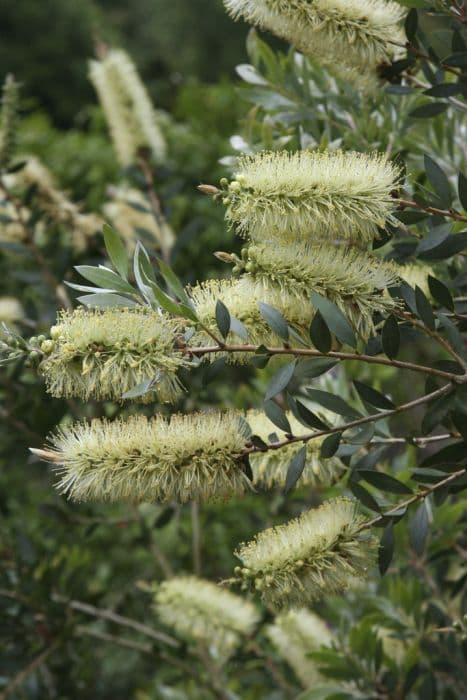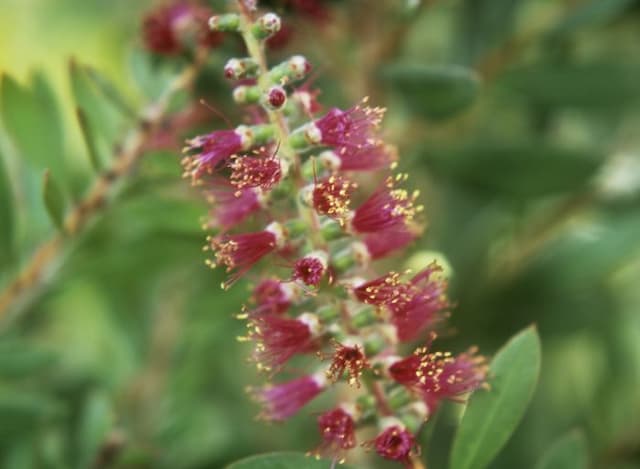Eucalyptus coccifera

ABOUT
The plant in question, commonly referred to as the Tasmanian snow gum, is an evergreen tree that is distinguished by its distinct bark and foliage. Starting with its bark, it is a prominent feature that offers a smooth texture, often showcasing a patchwork of colors ranging from white and cream to grey and sometimes even having a pinkish tinge. This multicolored bark can peel away in strips, revealing a fresh and brightly colored layer underneath. The leaves of the Tasmanian snow gum are a characteristic element, which transition throughout the plant's life. Initially, juvenile foliage takes on a more rounded and blue-green hue, which as it matures, elongates into a lance shape, eventually turning a glossy green shade. Moreover, the leaves exude a fresh, aromatic fragrance when crushed, which is commonly associated with many plants in its family. As with many flowering trees, the plant produces clusters of flowers. These flowers can range in color but are often seen as white, cream, or yellowish, and they form in groups that can either be very conspicuous or somewhat less showy, depending on the time of year and specific growing conditions. After flowering, it produces a woody fruit commonly called a gum nut, which is generally shaped like a small cup or cone, holding seeds that are later dispersed into the environment. Throughout the different seasons, the plant can change in appearance, with its bark sometimes becoming more dramatically colored in colder weather, and its leaves might turn to a paler green or blue-green during different growth phases. The overall impression that the Tasmanian snow gum gives is one of hardiness and adaptability, with a striking appearance that makes it a memorable feature in any landscape where it is grown.
About this plant
 Names
NamesFamily
Myrtaceae
Synonyms
Tasmanian Snow Gum, Mount Wellington Peppermint
Common names
Eucalyptus coccifera.
 Toxicity
ToxicityTo humans
Eucalyptus, specifically Eucalyptus coccifera, contains compounds that are toxic to humans. The oil, which is the most toxic part, can cause poisoning if ingested. Symptoms of eucalyptus poisoning may include abdominal pain, nausea, vomiting, diarrhea, dizziness, or feelings of suffocation. In severe cases, ingesting eucalyptus oil can lead to central nervous system depression and can be potentially life-threatening.
To pets
Eucalyptus is also toxic to pets. If animals consume parts of Eucalyptus coccifera, they can experience similar symptoms as in humans, such as salivation, vomiting, diarrhea, depression, and weakness. In severe cases, ingestion can lead to seizures and collapse. Pet owners should keep eucalyptus plants and products containing eucalyptus oil out of reach of their animals to prevent poisoning.
 Characteristics
CharacteristicsLife cycle
Perennials
Foliage type
Evergreen
Color of leaves
Blue-green
Flower color
White
Height
30 feet (9 meters)
Spread
20 feet (6 meters)
Plant type
Tree
Hardiness zones
7
Native area
Australia
Benefits
 General Benefits
General Benefits- Ornamental Value: Eucalyptus coccifera, commonly known as Tasmanian snow gum, is often used in landscaping for its striking appearance and evergreen foliage.
- Habitat Support: The tree provides essential habitat and food for various wildlife species, including birds and insects.
- Windbreak: Due to its robust and tall nature, Tasmanian snow gum can be planted as a windbreak to protect crops and soil from erosion.
- Shade Provider: Its broad canopy offers ample shade, which can be beneficial in parks, gardens, and rural landscapes.
- Drought Tolerance: Tasmanian snow gum is known for its ability to withstand periods of drought, making it suitable for xeriscaping and arid environments.
- Timber Production: The wood of Eucalyptus coccifera is valued for various uses, including construction and furniture making, due to its durability.
- Erosion Control: Its extensive root system can help stabilize soil in areas prone to erosion, such as slopes and riverbanks.
- Honey Production: Flowers of the Tasmanian snow gum can provide nectar for honeybees, supporting local apiculture and contributing to honey production.
- Cultural Significance: As a native Australian species, it holds cultural significance for indigenous communities and contributes to biodiversity conservation efforts.
 Medical Properties
Medical Properties- Antimicrobial: Eucalyptus coccifera contains compounds such as cineole that have antimicrobial properties.
- Anti-inflammatory: The essential oils extracted from Eucalyptus coccifera can have anti-inflammatory effects.
- Expectorant: Eucalyptus oil, known to be derived from several eucalypt species, can act as an expectorant for relieving congestion.
- Analgesic: Eucalyptus coccifera may have pain-relieving properties.
 Air-purifying Qualities
Air-purifying QualitiesThis plant is not specifically known for air purifying qualities.
 Other Uses
Other Uses- Eucalyptus coccifera, commonly known as Tasmanian snow gum, can be used as a natural dye source. The leaves produce a range of colors when used in fabric dyeing, especially on wool.
- The wood of the Tasmanian snow gum is used in craftwork for making small wooden items such as bowls, picture frames, and intricate trinkets due to its fine grain and attractive finish.
- This plant's ornamental bark peels away in strips, which can be utilized in decorative arts or as a textural element in sculptures and collages.
- The tree's distinctive visual appearance lends itself to landscape photography, thereby providing an economic benefit to photographers and print sellers.
- Dried leaves of Tasmanian snow gum can be incorporated into potpourri mixes for a unique fragrance and as a natural insect repellent due to its eucalyptus smell.
- The robust nature of this eucalypt makes it suitable for windbreaks or shelter belts in agricultural regions, helping to protect crops and soil from wind erosion.
- Tasmanian snow gum flowers provide a valuable source of nectar and pollen for honeybees, which can result in a uniquely flavored honey specific to regions where this eucalypt is prevalent.
- The plant's fast growth rate and adaptability to various soil conditions make it a candidate for reforestation projects and land rehabilitation efforts.
- Wood chips from the Tasmanian snow gum can be used in the production of essential oils, mulches, or as a carbon-rich material in composting.
- The leaves are occasionally used in the crafting of eucalyptus leaf wreaths and other floral decorations for their pleasing aesthetic and scent.
Interesting Facts
 Feng Shui
Feng ShuiThe Tasmanian snow gum is not used in Feng Shui practice.
 Zodiac Sign Compitability
Zodiac Sign CompitabilityThe Tasmanian snow gum is not used in astrology practice.
 Plant Symbolism
Plant Symbolism- Healing: Eucalyptus coccifera, commonly known as Tasmanian snow gum, is often associated with healing due to its medicinal properties and the purifying scent of its essential oils, which are thought to have therapeutic effects.
- Protection: The robust nature of the snow gum, able to withstand cold and harsh conditions, symbolizes protection and the ability to endure challenging environments.
- Cleansing: The leaves of the snow gum, when crushed, release a clean, fresh scent that is often connected with cleanliness and the ability to clear negative energy, making it symbolic of purification and refreshment.
- Renewal: Snow gums have the capability to regenerate after fires, symbolizing renewal and the ability to bounce back after adversity or illness.
 Water
WaterThe Tasmanian snow gum should be watered deeply but infrequently, allowing the soil to dry out between waterings. Generally, this means watering every 7-10 days during hot, dry weather and less often during cooler, rainy periods. Use about 2 gallons of water for a young tree, increasing the amount as the tree matures and its root system grows. Consistently dry soil or extended drought periods may require more frequent watering, but it's important not to overwater as this tree prefers drier conditions.
 Light
LightTasmanian snow gum prefers full sun, thriving with at least 6-8 hours of direct sunlight daily. It's best situated in a location where it can receive unfiltered sunlight throughout the day to ensure healthy growth and abundant foliage.
 Temperature
TemperatureTasmanian snow gum can withstand a wide range of temperatures, but it grows best when the temperature is between 60°F and 75°F. It can tolerate cold down to about 20°F and can survive temporary dips as low as 10°F. It's important to protect the tree from extreme cold when it is young.
 Pruning
PruningPruning Tasmanian snow gum is often done to maintain a desired shape and remove any dead or damaged branches, promoting healthy growth. Prune during the late winter or early spring when the tree is dormant. Pruning every 2 to 3 years is typically sufficient, but yearly inspection can determine if more frequent pruning is necessary.
 Cleaning
CleaningAs needed
 Soil
SoilTasmanian Snow Gum requires well-draining soil mixed with sand and loam. A pH range of 6.0 to 7.5 is ideal for optimal growth. Combine equal parts of standard potting soil, coarse sand, and peat to create a suitable mix.
 Repotting
RepottingTasmanian Snow Gum should be repotted every few years or when it outgrows its current pot. Young plants may need repotting annually, whereas mature trees less frequently.
 Humidity & Misting
Humidity & MistingTasmanian Snow Gum prefers low to moderate humidity levels but can tolerate a range of conditions. Avoid environments that are too humid to prevent fungal issues.
 Suitable locations
Suitable locationsIndoor
Provide full light and low humidity indoors for Tasmanian Snow Gum.
Outdoor
Plant in well-draining soil, full sun, protect from extreme cold.
Hardiness zone
7-10 USDA
 Life cycle
Life cycleEucalyptus coccifera, commonly known as Tasmanian Snow Gum, begins its life cycle when its seeds germinate in moist, well-drained soil, often after a fire has reduced competition and released the seeds from their capsules. As a seedling, it rapidly establishes a strong root system and begins to grow vertically, forming a straight trunk with smooth, creamy-white to gray bark that sheds in patches. During the juvenile stage, it produces distinctive, circular, blue-green juvenile leaves which are large and sessile. As the tree matures, its leaves transition to a more elongated, sickle shape and become a glossy green; this marks the tree's adult phase, in which it becomes capable of flowering. Flower buds form in groups, and upon maturity, the tree produces white flowers that are pollinated by birds, bees, and other insects. Following pollination, seed capsules (gum nuts) develop, which mature and release seeds to start the next generation, completing the life cycle.
 Propogation
PropogationPropogation time
Spring to Summer
Propogation: The most popular method to propagate Eucalyptus coccifera, commonly known as the Tasmanian snow gum, is through seed sowing. The best time to sow the seeds is during late winter or early spring when the temperatures are cool, which is favorable for germination. To propagate from seed, one should first collect the capsules after they have dried on the tree, and then extract the seeds. It is important to use a well-draining growing medium and to very lightly cover the seeds with a fine layer of soil as they require light for germination. Consistent moisture should be maintained, but care must be taken to avoid waterlogging. Germination can take anywhere from two to three weeks, and once seedlings are big enough to handle, they can be potted individually.







![New Zealand myrtle [Black Pearl]](/_next/image?url=https%3A%2F%2Fplants-admin.emdemapps.com%2Fimages%2Fplants%2F%2Fimages%2F604b53688d37e.png&w=640&q=75)

